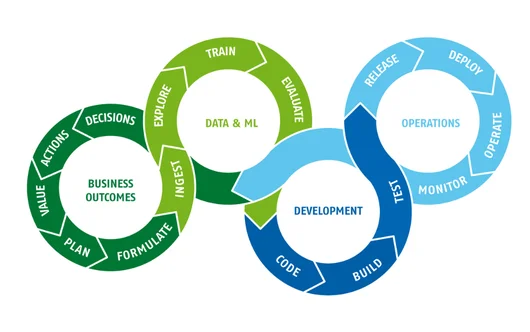To explain the meaning of MLOps, you first need to know what ML is. This is a subfield of artificial intelligence (AI), in which computers are taught to learn and make decisions based on patterns the system has previously discovered in historical data, without being explicitly programmed to do so. In other words, machine learning algorithms are designed to analyze data and identify patterns in that data, and then use those patterns to make predictions or provide advice.
MLOps: for a perfect Machine Learning Pipeline

More and more organizations are open to using Machine Learning (ML). Through this relatively new science, they can predict consumer behavior, give advice on warehouse layouts, for example, or answer questions about building structures, for example. A prerequisite for the successful application of ML, is that the ML models contribute structurally to organizational goals. In other words, the Machine Learning Pipeline needs to be in good order. That is where MLOps comes in.
Potential MLOps
Many organizations, and computer users in general, are beginning to discover the unprecedented potential of ML. For example, ML can make connections between causes and effects based on vast amounts of data, creating predictive and advisory algorithms that surpass the accuracy of humans. So ML is truly a gamechanger in various sectors; from healthcare to finance, and everything in between.
No Machine Learning Pipeline
What often makes bringing an ML model into production difficult is the lack of a smooth and accountable process for applying the models in day-to-day operations. In other words, the Machine Learning pipeline is missing. This is true not only for ML, by the way, but for data science models in general. Most organizations are only recently experimenting with data science or ML, and thus do not yet have a systematic approach/ Machine Learning Pipeline for integration with business applications. Those organizations can find guidance in MLOps.
What is MLOps?
Now we come to the question: what is MLOps? MLOps is a set of practices and tools (a method) that combines ML and data science in general with DevOps (Development and Operations) methodologies. This combination creates a robust and efficient flow for deploying, monitoring and updating ML models. What such a flow looks like is shown in the image below.

Core principles for a Machine Learning Pipeline
MLOps consists of seven core principles. Each principle has its own set of tools and techniques to ensure that models are accurate, reliable and up-to-date. These include data version control systems, automated test frameworks, continuous integration and deployment (CI/CD) pipelines, and monitoring and logging tools.
Below is a description of the seven core principles.
- Versioning: the systematic tracking of versions of ML models, data, parameters and code to ensure traceability and repeatability (stakeholders: data scientists, data engineers).
- Testing: conducting various tests, such as unit and validation tests, to ensure the quality and effectiveness of ML models (stakeholders: data scientists, data engineers).
- Reproducibility: standardizing and documenting the entire ML process, from data collection to modeling, to ensure consistency and repeatability of experiments (stakeholders: data scientists, data engineers).
- Deployments: the controlled and reproducible deployment of ML models in production environments (stakeholders: data engineers, IT operations).
- Automation: streamlining the ML pipeline by automating processes, such as data collection, model training and deployment, to promote efficiency and consistency (stakeholders: data scientists, data engineers, IT operations).
- Monitoring: continuously observing the performance of deployed models, data input quality and infrastructure, to quickly identify any problems or anomalies (stakeholders: data scientists, data engineers, IT operations).
- Ways of working: promoting collaboration and following best practices in coding and documentation, to create an integrated and efficient working environment (stakeholders: data scientists, data engineers, business stakeholders).
In each of these principles, there is a need for close collaboration between different roles, such as data scientists and data engineers. In addition, there must be a strong connection to the business. Only then can you ensure that the models and Machine Learning Pipelines being developed deliver value to the organization.
Want to know how these core principles can be applied in practice? You will soon read about this in article two of this three-part article on MLOps: MLOps in practice: how do you quickly extract value from data?
Crucial role
ML is becoming an increasingly important field. This will also further increase the importance of MLOps. No other method currently plays such a crucial role in helping organizations realize the benefits of ML while minimizing risks and costs.
Are you interested in MLOps? Then keep an eye on Insights for the next article on this topic: MLOps in practice: how do you quickly extract value from data?